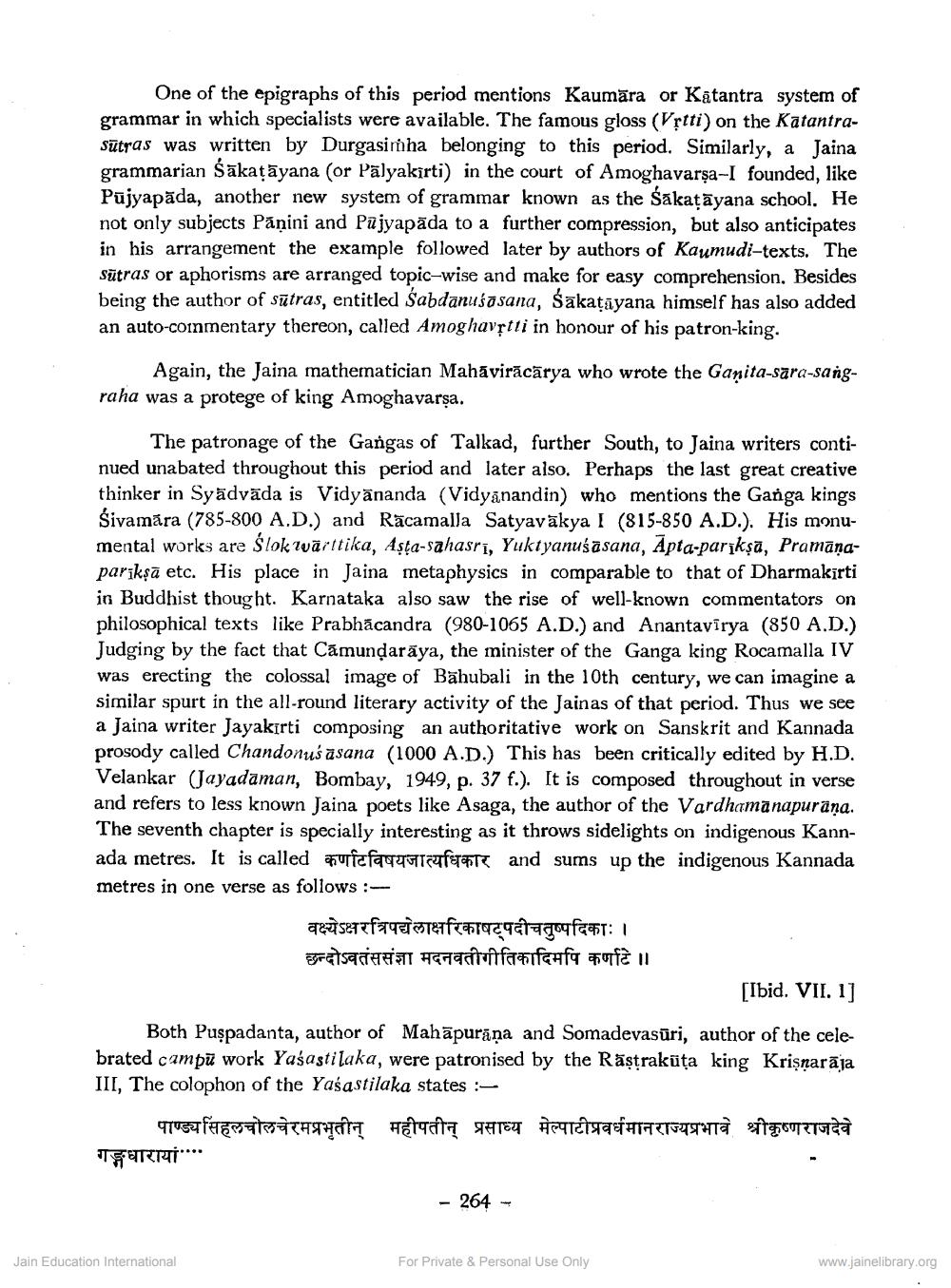Book Title: Contribution of Karnataka to Jain Literature and Culture Author(s): K Krishnamoorthy Publisher: Z_Kailashchandra_Shastri_Abhinandan_Granth_012048.pdf View full book textPage 8
________________ One of the epigraphs of this period mentions Kaumāra or Katantra system of grammar in which specialists were available. The famous gloss (Vștti) on the KatantraSūtras was written by Durgasimha belonging to this period. Similarly, a Jaina grammarian sākatāyana (or Pälyakīrti) in the court of Amoghavarşa-I founded, like Pujyapāda, another new system of grammar known as the Sakatāyana school. He not only subjects Pāṇini and Pajyapāda to a further compression, but also anticipates in his arrangement the example followed later by authors of Kaumudi-texts. The Sūtras or aphorisms are arranged topic-wise and make for easy comprehension. Besides being the author of sūtras, entitled Sabdanuśasana, Sakatayana himself has also added an auto-coinmentary thereon, called Amoghavștti in honour of his patron-king. Again, the Jaina mathematician Mahavirācārya who wrote the Ganita-sara-sangraha was a protege of king Amoghavarşa. The patronage of the Gangas of Talkad, further South, to Jaina writers continued unabated throughout this period and later also. Perhaps the last great creative thinker in Syädväda is Vidyänanda (Vidyanandin) who mentions the Ganga kings Śivamára (785-800 A.D.) and Rācamalla Satyavākya I (815-850 A.D.). His monumental works are ślokwärttika, Asta-sahasri, Yuktyanusasana, Āpta-parikṣā, Pramānaparikṣā etc. His place in Jaina metaphysics in comparable to that of Dharmakīrti in Buddhist thought. Karnataka also saw the rise of well-known commentators on philosophical texts like Prabhācandra (980-1065 A.D.) and Anantavīrya (850 A.D.) Judging by the fact that Camundarāya, the minister of the Ganga king Rocamalla IV was erecting the colossal image of Bahubali in the 10th century, we can imagine a similar spurt in the all-round literary activity of the Jainas of that period. Thus we see a Jaina writer Jayakirti composing an authoritative work on Sanskrit and Kannada prosody called Chandonus asana (1000 A.D.) This has been critically edited by H.D. Velankar (Jayadaman, Bombay, 1949, p. 37 f.). It is composed throughout in verse and refers to less known Jaina poets like Asaga, the author of the Vardhamanapurāņa. The seventh chapter is specially interesting as it throws sidelights on indigenous Kannada metres. It is called fufcfa Fifat and sums up the indigenous Kannada metres in one verse as follows : वक्ष्येऽक्षरत्रिपद्येलाक्षरिकाषट्पदीचतुष्पदिकाः । छन्दोऽवतंससंज्ञा मदनवतीगीतिकादिमपि कर्णाटे । [Ibid. VII. 1] Both Puspadanta, author of Mahāpurāņa and Somadevasūri, author of the celebrated campū work Yasastilaka, were patronised by the Răstrakūta king Krişnarāja III, The colophon of the Yaśastilaka states : पाण्ड्यसिंहलचोलचेरमप्रभृतीन् महीपतीन् प्रसाध्य मेल्पाटीप्रवर्धमानराज्यप्रभावे श्रीकृष्णराजदेवे TGETTRI. - 264 - Jain Education International For Private & Personal Use Only www.jainelibrary.orgPage Navigation
1 ... 6 7 8 9 10 11
